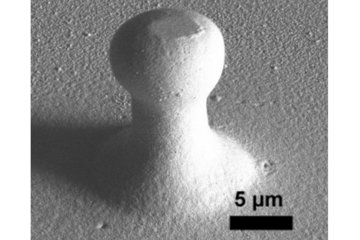All genres
541.
Journal Article
The maximum separation cluster analysis algorithm for atom-probe tomography: Parameter determination and accuracy. Microscopy and Microanalysis 20 (6), pp. 1662 - 1671 (2014)
542.
Journal Article
Integrated experimental–simulation analysis of stress and strain partitioning in multiphase alloys. Acta Materialia 81, pp. 386 - 400 (2014)
543.
Journal Article
Strain localization and damage in dual phase steels investigated by coupled in-situ deformation experiments and crystal plasticity simulations. International Journal of Plasticity 63, pp. 198 - 210 (2014)
544.
Journal Article
Deformation mechanisms in an austenitic single-phase duplex microstructured steel with nanotwinned grains. Acta Materialia 81, pp. 487 - 500 (2014)
545.
Journal Article
Intrinsic and extrinsic size effects in the deformation of amorphous CuZr/nanocrystalline Cu nanolaminates. Acta Materialia 80, pp. 94 - 106 (2014)
546.
Journal Article
In situ observation of collective grain-scale mechanics in Mg and Mg-rare earth alloys. Acta Materialia 80, pp. 77 - 93 (2014)
547.
Journal Article
New insights into the austenitization process of low-alloyed hypereutectoid steels: Nucleation analysis of strain-induced austenite formation. Acta Materialia 80, pp. 296 - 308 (2014)
548.
Journal Article
Interfacial dislocation motion and interactions in single-crystal superalloys. Acta Materialia 79, pp. 216 - 233 (2014)
549.
Journal Article
Smaller is less stable: Size effects on twinning vs. transformation of reverted austenite in TRIP-maraging steels. Acta Materialia 79, pp. 268 - 281 (2014)
550.
Journal Article
Elemental partitioning and mechanical properties of Ti- and Ta-containing Co–Al–W-base superalloys studied by atom probe tomography and nanoindentation. Acta Materialia 78, pp. 78 - 85 (2014)
551.
Journal Article
Composition Dependance of Phase Stability, Deformation Mechanisms, and Mechanical Properties of the CoCrFeMaNi High-Entropy Alloy System. JOM 66 (10), pp. 1993 - 2001 (2014)
552.
Journal Article
Structure of rapidly quenched (Cu0.5Zr0.5)100-xAgx alloys (x=0-40 at.%). Journal of Alloys and Compounds 607, pp. 285 - 290 (2014)
553.
Journal Article
Precipitation and austenite reversion behavior of a maraging steel produced by selective laser melting. Journal of Materials Research 29 (17), pp. 2072 - 2079 (2014)
554.
Journal Article
Segregation stabilizes nanocrystalline bulk steel with near theoretical strength. Physical Review Letters 113 (10), 106104 (2014)
555.
Journal Article
Ultrastructural organization and micromechanical properties of shark tooth enameloid. Acta Biomaterialia 10 (9), pp. 3959 - 3968 (2014)
556.
Journal Article
Texture and microstructure evolution during non-crystallographic shear banding in a plane strain compressed Cu–Ag metal matrix composite. Acta Materialia 76, pp. 238 - 251 (2014)
557.
Journal Article
Designing Heusler nanoprecipitates by elastic misfit stabilization in Fe–Mn maraging steels. Acta Materialia 76, pp. 94 - 105 (2014)
558.
Journal Article
Texture Evolution as Determined by In situ Neutron Diffraction During Annealing of Iron Deformed by Equal Channel Angular Pressing. Metallurgical and Materials Transactions a-Physical Metallurgy and Materials Science 45A (10), pp. 4235 - 4246 (2014)
559.
Journal Article
Large recovery strain in Fe–Mn–Si-based shape memory steels obtained by engineering annealing twin boundaries. Nature Communications 5, 4964 (2014)
560.
Journal Article
Designing quadplex (four-phase) microstructures in an ultrahigh carbon steel. Materials Science and Engineering A: Structural Materials Properties Microstructure and Processing 612, pp. 46 - 53 (2014)











